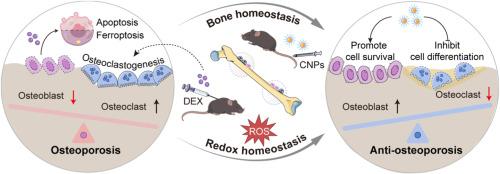氧化铈纳米颗粒通过促进骨生成和抑制破骨细胞生成来防止糖皮质激素诱导的骨稳态失衡
IF 10.2
1区 医学
Q1 ENGINEERING, BIOMEDICAL
引用次数: 0
摘要
长期服用糖皮质激素引起的骨质疏松症是一个常见的临床问题。目前的抗骨质疏松治疗主要集中在单方抑制骨吸收或促进骨形成。然而,骨形成和骨吸收之间的不平衡常常导致治疗效果欠佳。本研究证实了地塞米松(DEX)(一种典型的糖皮质激素)触发GIO的途径,并探讨了氧化铈纳米颗粒(CNPs)缓解GIO的治疗潜力和潜在机制。我们的研究结果表明,dex诱导的骨稳态失衡是小鼠GIO发展的主要机制。具体来说,DEX通过诱导细胞凋亡和铁下垂来抑制成骨前细胞的增殖和分化。同时,DEX促进破骨细胞前体增殖和分化,显著加速骨吸收。CNPs通过调节Keap1/Nrf2信号通路改善细胞内活性氧(ROS)积累,显著减轻dex诱导的骨稳态破坏。在成骨方面,CNPs能够通过调控GPX4/ACSL4信号通路,减轻dex诱导的成骨前细胞凋亡和铁凋亡。在骨吸收方面,CNPs抑制rankl依赖的破骨细胞形成途径。这些发现验证了无机纳米颗粒在GIO预防中的潜在应用。本文章由计算机程序翻译,如有差异,请以英文原文为准。

Ceria nanoparticles guard against glucocorticoid induced bone homeostasis imbalance through the promotion of osteogenesis and inhibition of osteoclastogenesis
Osteoporosis induced by the long-term administration of glucocorticoids is a common clinical problem. Current anti-osteoporosis therapies mainly focus on bone resorption inhibition or bone formation promotion unilaterally. However, the imbalance between bone formation and resorption often leads to suboptimal therapeutic outcomes. This study confirms the pathways through which dexamethasone (DEX), a typical glucocorticoid, triggers GIO, and explores both the therapeutic potential and underlying mechanisms of ceria nanoparticles (CNPs) in mitigating GIO. Our results demonstrate that DEX-induced bone homeostasis imbalance is the primary mechanism underlying GIO development in mice. Specifically, DEX inhibits pre-osteoblast proliferation and differentiation by inducing apoptosis and ferroptosis. Concurrently, DEX promotes osteoclast precursor proliferation and differentiation, significantly accelerating bone resorption. Administration of CNPs significantly mitigates DEX-induced disruption of bone homeostasis by ameliorating intracellular reactive oxygen species (ROS) accumulation via regulation of the Keap1/Nrf2 signaling pathway. Regarding osteogenesis, CNPs are capable of alleviating DEX-induced pre-osteoblast apoptosis and ferroptosis through the regulation of GPX4/ACSL4 signaling pathway. In terms of bone resorption, CNPs inhibit the RANKL-dependent osteoclast formation pathway. These findings validate the potential application of inorganic nanoparticles in GIO prevention.
求助全文
通过发布文献求助,成功后即可免费获取论文全文。
去求助
来源期刊

Materials Today Bio
Multiple-
CiteScore
8.30
自引率
4.90%
发文量
303
审稿时长
30 days
期刊介绍:
Materials Today Bio is a multidisciplinary journal that specializes in the intersection between biology and materials science, chemistry, physics, engineering, and medicine. It covers various aspects such as the design and assembly of new structures, their interaction with biological systems, functionalization, bioimaging, therapies, and diagnostics in healthcare. The journal aims to showcase the most significant advancements and discoveries in this field. As part of the Materials Today family, Materials Today Bio provides rigorous peer review, quick decision-making, and high visibility for authors. It is indexed in Scopus, PubMed Central, Emerging Sources, Citation Index (ESCI), and Directory of Open Access Journals (DOAJ).
 求助内容:
求助内容: 应助结果提醒方式:
应助结果提醒方式:


